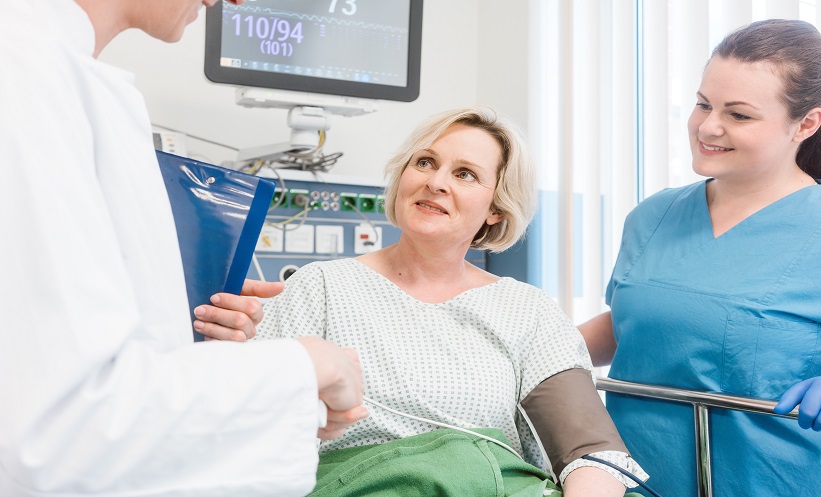Interviewees: Richard Russell
Lymington New Forest Hospital, Lymington, UK
Disclosure: Dr Russell has declared no conflicts of interest.
Acknowledgements: Medical writing assistance was provided by Amanda Barrell, Brighton, UK.
Support: The publication of this article was funded by Omron Healthcare.
Citation: EMJ Respir. 2021;9[Suppl 1]:2-6.
Interview Summary
While not every wheeze is asthma, no wheeze is normal. Detecting and documenting the breathing sound accurately and objectively, then, is an essential part of the paediatric respiratory disease diagnostic and management pathways. It can ensure children receive life-enhancing medication as soon as possible and avoid the symptom exacerbations that can result in asthma attacks, hospital admissions, and mortality. Ruling out wheeze is also important because it can provide families with the reassurance they need to live their lives to the full.
Objectively detecting wheeze and differentiating it from other breathing sounds, however, is not always straightforward. Patients and healthcare professionals often have different definitions of wheeze. In addition, chest examinations require a certain subtlety of technique that can lead to wheeze being missed in the clinic.
Dr Richard Russell, consultant respiratory physician at Lymington New Forest Hospital, Senior Clinical Researcher at the University of Oxford, and Clinical Lead for respiratory medicine in the Southeast of England, spoke about the importance and challenges of detecting wheeze in children. He also explained how the coronavirus disease (COVID-19) has further compounded the barriers to objective detection, and the role new technologies could play in the monitoring and management of chronic respiratory diseases.
WHAT IS A WHEEZE?
Dr Russell explained that a wheeze is a polyphonic noise made in the airway, usually on expiration. A noise on inhalation, he added, was known as stridor.1 While it usually implies that the airway is narrowed, he said, it does not tell you why. “It is a measure of disturbed airflow in a narrowed airway.”
Wheeze is often associated with asthma, but it may also be indicative of a foreign body, bronchitis, or bronchiolitis.1 A monophonic noise similar to a whistle, Dr Russell said, may suggest the patient, often a child, has swallowed an object, whereas multifrequency sounds are usually a sign of an airway disease, such as asthma.
While not every wheeze is asthma, no wheeze is normal. As such, it is an “extremely important finding” in children, said Dr Russell, explaining that lung function continues to develop until around the age of 20 to 25.2 “Children have smaller airways than adults so they cannot handle the same degree of airflow limitation. Airflow in a tube is proportional to the inverse of the fourth power of the radius. That means that if you’ve got small airways and you decrease them significantly, you’re going to get a lot of change [loss] in airflow,” he explained.
Wheeze, which should always be an objective finding rather than a subjective description, is a crucial part of the asthma diagnostic and management pathways. It helps clinicians to detect the condition early and spot deterioration in symptoms postdiagnosis.
ASTHMA IMPACTS LIVES
Asthma is the most common chronic respiratory disease in the UK. A total of 1.1 million children and 4.3 million adults are currently receiving treatment for the condition but due to underdiagnosis, the number of people affected by it is likely to be higher.3 It can have a huge impact on people’s lives and livelihoods. “It affects people day to day,” Dr Russell explained. “Asthma in children leads directly to days off school4 and parents taking days off work. It has an important financial impact on the individual and the family group, as well as all the worry and the psychological issues.”5
Despite the availability of effective treatments, around 1,500 people die from an asthma attack every year in the UK.3 “If you are asthmatic and you get too much of the wrong stimulus (your trigger factor), you can end up in hospital or even dying from your disease. Living with asthma is hugely impactful and it is scary,” said Dr Russell, adding that the impact was felt by the whole family.
The earlier a child is diagnosed with asthma, the quicker they will be prescribed the right treatment and, along with their family, receive the education they need to manage their condition. Dr Russell said: “The most important message in asthma is that treatment works. The inhalers we use reduce morbidity, reduce mortality, reduce admissions to hospital, reduce the symptoms of wheezing, and people can have a normal life.6 If you don’t have the right diagnosis, you can’t get the right treatment.”
DETECT AND DOCUMENT
Because of its relapsing/remitting nature, asthma can sometimes be tricky to diagnose. “Asthma is a disease of airway inflammation that comes and goes. You might feel fantastic with normal lungs and no noises one day. The next day you might be exposed to some dust or pollen, then you feel unwell and your lungs are tight. So, making that diagnosis can sometimes be difficult,” said Dr Russell.
Documenting a wheeze and the context in which it came about, such as potential triggers, is an important part of the ‘diagnostic jigsaw’. As such, it is recommended in the 2019 British Thoracic Society (BTS)/Scottish Intercollegiate Guidelines Network (SIGN) British Guideline on the Management of Asthma, which was coauthored by Dr Russell.7 “We would align that with things like lung function tests, peak flow meters etc., but documenting wheeze is absolutely vital when it comes to the diagnosis of obstructive lung diseases […] it really helps with that early proactive diagnosis.”
Documenting a wheeze is just as important as detecting it, he explained. “Someone might have had one episode of wheeze when they were 5, then come back when they are 10 or 11. If it has been documented, we can see that they have asthma, and it has developed over that time.”
THE OBJECTIVE WHEEZE
Objectivity is the key to detecting and documenting a wheeze, and to being able to accurately diagnose an obstructive airway condition such as asthma. “A wheeze is not saying they feel a bit breathless. A wheeze is saying ‘I can hear a noise’,” said Dr Russell. “We want to be able to say that this is a wheeze, rather than another noise.”
There are a number of challenges to this objectivity, however. Language is the first. Different communities, even different communities within a single country, will use different words to describe wheeze. What’s more, there is usually a gulf between what parents/patients and healthcare professionals define as wheeze; the two groups disagree on the presence of a wheeze more than 50% of the time, Dr Russell explained.8
“A wheeze is a polyphonic noise made on expiration, caused by airflow obstruction, […] it’s a very specific definition. Whereas I often think parents, patients, and children will describe any kind of noise they hear when breathing out as wheeze, and that could just be breathing hard,” said Dr Russell.
Children under the age of 3 or 4 years tend to breathe through their mouths when they are sick, and parents can, for example, mistake this for wheezing. “If they are ill, they’ll breathe with their mouths and they can generate quite a lot of noise in the upper airway. Is that a wheeze? Not really, it’s an upper airway noise caused by a strain on the neck.”
In the general population, he said, people often get mixed up and use the word wheeze to describe any breathing noise. This is further complicated by the fact that they are listening to what comes out of the throat and mouth, rather than the noises in the lungs as heard through a stethoscope. That, Dr Russell added, was not very specific or helpful.
In this sense, objectively ruling out a wheeze is just as important as accurately detecting one, especially in children who are living with a chronic respiratory condition like asthma. The presence of a wheeze can cause a great deal of concern among families. Not only is it a reminder of the child’s health issues, but it is also a sign that the condition is not adequately controlled. “That in itself will be impacting on quality of life and the anxiety that it leads to as a parent is potentially enormous. I am sure that hundreds, if not thousands, of attendances at paediatric emergency departments are because of a listened-to wheeze by the parents.”
In addition, some parents may not want to use the word ‘wheeze’ when describing signs and symptoms as it could be seen as an admission that something serious is wrong. “We need to encourage people to be aware of their lungs and their breathing, but we mustn’t let them overinterpret things,” said Dr Russell.
TECHNIQUE AND CIRCUMSTANCE
Healthcare professionals detect a wheeze by using a stethoscope to listen to the lungs. However, achieving an objective detection is not always as straightforward as it sounds, said Dr Russell. Clinicians may be let down by the quality of their stethoscope or by their technique, he said. “We don’t always listen well and sometimes we do not have the right equipment to listen with.”
The Covid-19 pandemic has also had a detrimental impact on healthcare professionals’ ability to detect wheeze. The increase in telemedicine combined with infection control and social distancing measures mean many are either unable or unwilling to get close enough to their patients to listen to their chest, said Dr Russell.
WHEEZE IN PRACTICE
Talking about his approach to detecting wheeze and diagnosing respiratory issues in children, Dr Russell said the first step was asking them and their families to describe the sound in their own words.
A holistic assessment is next, he said, adding that understanding the whole picture is “absolutely essential.” His questions tend to include:
- When did it happen?
- How did it happen?
- What did you do about it?
- Did it get better or worse?
- Did it respond to treatment?
- What were the triggers?
- How long did it last?
- Has it happened before?
This kind of conversation not only enables diagnosis, but it also helps to establish the rapport needed for shared decision-making and patient-centred care later on, he said. “When you engage with a patient, you’re trying to understand what’s wrong with them. Then you have to help them to understand what’s wrong with them and understand what the treatments are […], everyone who has a problem with their health has a story, and listening to that story is essential.”
Dr Russell said there was a certain subtlety to the chest listening technique that “sometimes gets missed,” and this can be a barrier to accurate, objective wheeze detection. His advice was:
- Use a quality stethoscope.
- Ask the patient to breathe just a little deeper than normal.
- Avoid listening to the middle of the chest because breathing deeply can cause turbulent airflow in the larger airways.
- Don’t try to listen through clothes.
- Take a careful and methodological approach moving around the chest and listening to the whole respiratory cycle for two or three breaths at each point.
If a wheeze is detected, Dr Russell reiterated, it should always be documented.
WHEEZE AND COVID-19
The advent of Covid-19 has brought its own challenges to detecting wheeze, particularly in primary care. Dr Russell explained that some symptoms were being ignored, as people were concerned about the infection risk associated with presenting to healthcare services. Secondly, he said, teams are doing many more virtual clinics, and detecting a wheeze on the telephone or via a video link is very challenging.
In addition, healthcare professionals may be more reluctant to carry out an examination because of the risk of infection. “To examine your chest, I have to get quite close to you and your face. Also, people with asthma cough and that’s how the virus is transmitted. So Covid-19 has certainly had an impact on behaviour both by patients and by doctors.”
As the Covid-19 vaccination programme continues to roll out, there are ways that healthcare teams can minimise risk during a chest examination. These include wearing the appropriate personal protective equipment and “doing it right first time” to avoid repeat exposure.
When having to examine a child with a potential wheeze over a video call, healthcare professionals need to make use of all the visual cues they can, he recommended. “You’re looking at the pattern, their overall comfort, how they are breathing, and how their chest is performing.”
THE FUTURE OF WHEEZE DETECTION
New technologies have the potential to remove the element of doubt from wheeze detection, boosting objectivity, allowing for more accurate documentation, and enabling greater agreement between healthcare professionals and parents.
Dr Russell said that devices like WheezeScan (OMRON Healthcare, Hoofddorp, the Netherlands), which use artificial intelligence (AI) algorithms to listen to a child’s chest and return a wheeze or ‘no wheeze’ result, could provide all parties with greater confidence. “Devices that accurately and specifically diagnose wheeze are really useful. They will give us context and frequency in terms of making the diagnosis to begin with.”
Another important use, he went on, might be in disease monitoring. “To wait until someone complains of breathlessness takes time. If you could detect that wheeze a day or two earlier, you could intervene and do whatever is needed to stop it developing into an asthma attack,” he said.
“There is also an element of reassuring parents, particularly those with more severe disease, that their kids are okay. We generally agree with the parents and kids about what wheezing is less than half of time,8 so that objectivity and the ability to keep an eye on it, and to believe each other, is really important.”
Such devices, which have an obvious benefit in the Covid-19 era when physical examinations are tricky, could also come to play an important role in self-management, Dr Russell said.
“When someone has asthma, my goal is to give them the tools they need to manage their disease successfully because I will not be with them all the time. Even my worse asthmatics, I only see for a couple of hours a year. They are out in the community the rest of the time, so they have got to learn to self-manage,” he said.
Devices that provide accurate, objective detection of wheeze could help in that process. Used as monitoring tools, they could provide reassurance day to day, while also helping people to understand deterioration in symptoms and when they need to speak to their healthcare team. “I’d certainly want to see some good studies to show that you can actually improve self-management and improve self-empowerment in that way,” said Dr Russell.







